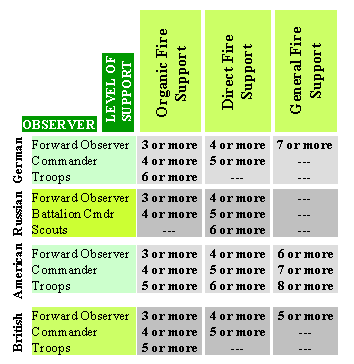Battlefront WWII
Introduction to Call-for-Fire
Calling for Fire

If an artillery unit cannot see a target, they need someone else to tell them where it is and if they are hitting it.
This is the essence of "Calling for Fire". There are two essential elements to calling for fire:
-
An observer who is capable of seeing the target and requesting a fire mission.
The observer must be able to
contact the firing unit or battery. This can be done by telephone, radio, or even flags and hand-signals.
The observer must also be skilled enough to adjust fire onto the target.
-
A firing element (gun, battery, or battalion) who is able and authorized to respond to a request for fire.
The firing element must be allowed to respond to the request for fire. If they are not assigned to help you, or
are busy elsewhere, you won't get your fire mission.
In Battlefront WWII, all of the above considerations into a single die roll on the Call-for-Fire table.
This table shows the chance of successfully calling for fire based on:
- Nationality
- Observer type
- Level of Support
Nationality
Different nations had different doctrine for calling for artillery fire. We are going to examine some of these
in excruciating detail later in the tutorial.
Observers
Forward Observers
Forward observers are trained to call for fire missions. They have special radio equipment and are authorized to contact
off-board artillery. Often they are the actual commander of an off-board battery. They will almost always have a
better chance of calling in fire missions. Also, with the exception of the Americans, FOs are the only ones who can
call for artillery in General Support.
Commanders
Commanders were often trained to act as observers, but did not usually have the skill of forward observers.
Troops
Troops were sometimes able to act as observers for artillery directly attached to their unit.
Scouts
Because of a lack of education and training, most Russian troops were not able call for fire missions. However, Russian
scouts were trained to act as observers.
Level of Support
Level of Support specifies how unit or battery is supposed to cooperate
with your forces. The level of support must be specified for every fire support element and unit capable of indirect fire.
The support level will determine which units can act as observers and also how easy the missions are to call.
Organic Support
Organic fire support is attached to a specific organization. Individual on-board units (guns and mortars) are attached
directly to a maneuver or headquarters element. Organic fire support elements are usually attached to a specific battle-group.
While organic support is the easiest to call, only units in its organization are allowed to act as observers.
For a good example, look at the German Infantry Battalion BG-10 (p.72) that has 3 80mm mortars as Organic Support
attachments and a German Heavy Mortar Platoon (FS-01) as an Organic Fire Support Element. Any unit in the entire Battalion can
act as an observer for the FS-01. However, as per p.58, the 3 80mm mortars MUST be attached to either a maneuver
element or the Headquarters element. Once a mortar has been attached, only units of that element may call
for fire from that mortar. This is why they usually are split out among the companies to give each company
its own organic support.
Direct Support
Direct support fire support elements are dedicated to the battle as opposed to a specific organization. They almost always
have their own forward observer, who can more effectively control them.
Unlike Organic fire support elements, DS elements can be called by any eligible observer.
However, the chances of successfully calling them is less, and
national differences in the Call-for-Fire chart will sometimes restrict the types of units that can be used as
observers. For all nationalities except for the U.S. only Forward Observers and Officers were trained to call fire.
Usually DS elements are off-board batteries or Battalions.
General Support
General support elements represent artillery that may be in use elsewhere and therefore is not available
for your fire mission.
Often, they are "slices" of fire support that are controlled by higher level organizations
(division, corps, and army) that usually do not take part in a Battlefront WWII battle. Therefore a roll for GS
is less likely to succeed. Also, with the noticeable exception of the Americans, the equipment and authorization
to call for General Support Artillery was available only to designated forward observers.
